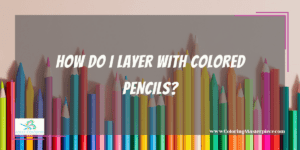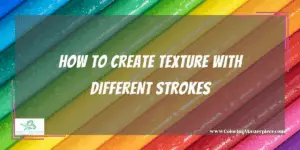Colored pencils are a popular choice for fans of adult coloring books. They are relatively inexpensive, easily transportable, not very messy, and can be sharpened to a very fine tip, which makes them a great choice for coloring in the intricate illustrations for which adult coloring pages are known. But can you use them to create effects like layering and blending?
When blending and layering colored pencils, using a light touch is key. Take care not to grip the pencil too hard, and leave plenty of space between your writing utensil and the paper. Remember that you can always add another layer of color, but once the pigment is on the page it is much harder to take it away. In other words, you can always go from lighter to darker, but you can’t go from darker to lighter. So start your first layer as light as possible, giving yourself room to gradually work darker.
Do not be afraid to leave plenty of white space on the page in your early layers; give yourself room to blend in more colors. You can use a different, complementary color, or different tints and shades of the same hue to give yourself a nice, textured look. Or, if you prefer, continue adding layers using the same pencil until you achieve the color you like.
Always use a properly sharpened pencil to get the most dynamic color possible. A nice, sharp tip will easily work around the paper’s teeth, or its natural nooks and crannies, allowing you to maximize the pigment’s color by filling in all of the page’s grooves. Just be sure to work up to such a full saturation by gradually building your layers; you do not want to use too much pressure and risk ripping or tearing your page.
Speaking of paper, you want to try to use a thicker stock that has some teeth to it, rather than an ultra-smooth copy paper. That thicker texture will allow you to build deeper colors by adding more layers, whereas a thinner stock that lacks teeth won’t accommodate as much color.
How do I Layer with Colored Pencils?

You can create gradient effects using many layers of the same pencil, or use complementary colors to create shadows that pop off the page and bring your illustrations to life. It is worth emphasizing again that it is best to start with a light grip. If you are having trouble not exerting too much pressure, try holding the pencil further back from the tip. Also, try to leave plenty of space between your hand and the paper; both of these techniques will help keep your base layer nice and light. If your first layer is too tight, you will burnish the page with waxy pigment too soon, and it will limit your ability to layer and blend additional colors.
Layering your colored pencils allows you to create and play with colors beyond those included in your set. Use a light touch with your first layer. Then choose a second color, either complimentary or a different shade of the same hue, and lightly add it on top of your first color. Keeping a gentle touch, try to fill in some of the white space left on the page.
How do I Blend Colored Pencils?
Colored pencils aren’t as soft and pliable as other mediums, like pastels, crayons, or even paint. Yet it is still possible to blend them in unique ways. Get creative and smooth out those pencil streaks with a blending stump. If you don’t have a blending stump handy, which is made out of very tightly wound paper, try using cotton balls, swabs, or even scraps of felt to blur and soften the lines in your coloring page.
For an extra saturated look, slightly dampen your blending tool with a small amount of water or even baby oil. Work the utensil over the selections that you want to smudge. You can even use your fingers to artfully blur the lines and give your illustration a surreal look. If you do play with this method, just be sure not to get your paper too wet, and you do not want to cause puckers or tears. It may help to experiment with scratch paper first before applying this technique to your favorite adult coloring book.
You can also blend with other colored pencils! Use a lighter colored pencil over darker layers, or even a white colored pencil. This method works best using medium to heavy pressure over the top of a few darker layers. You could also get fancy with a colorless blending pencil. These cool tools push the pigment around the paper, helping fill every nook and cranny of the page.
Check out some blending tips HERE.
How to Create Texture with Different Strokes

You may have already noticed that working with colored pencils may give you some visible pencil strokes. However, rather than fretting over some visible lines, you can use these as another creative tool in your toolbox and create different textures in your illustration. Straight lines, circles, and crosshatches are all different ways of filling in your coloring page. Now, consider for a moment the difference in how these techniques look. Straight back-and-forth lines may create a smoother look while coloring in circles can help an object look full and round.
By varying your strokes, you can create different dynamic textures on your coloring page. Varying your stroke and switching in different directions between layers can also help disguise your lines, giving the overall look a nice smooth feel. Keeping your pressure consistent will also help minimize the appearance of pencil lines.
Using a cross-hatch technique with two or more colors is a great way to blend them. To create a crosshatch, simply start with your lighter pencil and color back and forth in all directions. Then layer your second color over top, but going back and forth in the other direction (ie: side to side as opposed to top to bottom).
How to Create Highlights and Shadows
To highlight a particular area of your illustration, first, decide on the location of your light source. Your colors should be the lightest nearest to the light source and gradually get darker as you move farther away. Use your white pencil near your light source to emphasize the area. Next, use a darker color to add a shadow opposite the focal point of your light source. Try using a darker shade of the same hue, or choose an opposite, complementary color for a bold effect. Don’t be afraid to add some darker colors like brown and black or even navy and purple to make your shadows pop. Leave your layers nice and soft to avoid lines or streaks when you add your blender on top.
Feel free to get creative and experiment with different layering and blending techniques. Challenge yourself to see how many of these new techniques you can employ in one coloring page. Adult coloring is all about the artistic journey – you may surprise yourself with what you can come up with when working in your favorite adult coloring book. At the end of the day, coloring should be a fun and creative way to relax and unwind. It is a chance to let your imagination run free within its creative confines, and you should feel empowered to express yourself using and mediums at your disposal.
Frequently Asked Questions
How do I properly sharpen my pencil?
Your colored pencil works most efficiently when it is as sharp as possible; ideally, you want the tip to be sharp enough to fill in all of the paper’s teeth with pigment. Plus, very fine tips work well in the small, tight corners common in many adult coloring books. To get that super-fine tip, an electric sharpener will give you the most consistent sharpening. If you opt to use an analog hand-held pencil sharpener instead, try holding your pencil stationary while twisting the sharpener around it. This method should give you fewer annoying wood chips in your pencil tip.
What kind of colored pencils are best for layering and blending?
Not all colored pencils are created the same. Despite their name and appearance, colored pencils are pretty different in composition from good old number 2 pencils. They do not contain any lead or graphite. Rather, their core is made from a wax or oil base, which is added to a mixture of pigment, water, and bonding agents. Depending on the composition of their core, some pencils are softer than others. Softer pencils blend more easily and tend to work better for layering as well.
Can I layer and blend colored pencils with other mediums?
You can sure try! Since colored pencils tend to have a waxy substance, you may want to use them as your base and play with layering paint, markers, and even crayons on top.
Maximize the benefits of coloring with my free adult coloring eBook and by signing up for my email newsletter HERE!
Disclaimer: The information provided by ColoringMasterpiece.com (“The Site”) is for general informational purposes only. All information on the Site is provided in good faith, however, we make no representation or warranty of any kind, express or implied, regarding the accuracy, adequacy, validity, reliability, availability, or completeness of any information on the Site. Under no circumstance shall we have any liability to you for any loss or damage of any kind incurred as a result of the use of the Site or Reliance on any information provided on the Site. Your use of the Site and your reliance on any information on the Site is solely at your own risk. This blog post is for educational purposes only and does not constitute legal advice. Please consult a legal expert to address your specific needs.
Terms and Conditions: https://coloringmasterpiece.com/terms-and-conditions/
